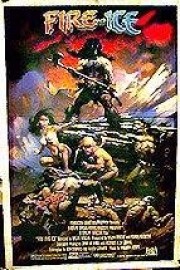Fire and Ice
One of the best decisions I think I’ve ever made when it comes to panels to go to at Atlanta’s Dragon*Con convention was in 2011, when I went to an 11:30am panel with animator Ralph Bakshi, whom I had only really known for two films at the time: his adaptation of part of “The Lord of the Rings,” and the X-rated “Fritz the Cat.” Listening to Bakshi look back on his career, and the highs and lows he’s endured in the creation of his art, was really eye-opening, and inspired me to seek out more of his films. That the first two films in that seeking were his fantasy films, “Wizards” and “Fire and Ice,” make sense given my admiration for the fantasy genre.
The thing that sticks out about Bakshi’s animation style is how it looks less cartoonish and more real in the way he draws his characters. Part of the reason Bakshi’s animation stands out from other works is the process in which he creates his images. Rather than just draw the cels, Bakshi directs actors to act out the motions for the characters, and then, using rotoscoping, draws over the footage. That is what lends the characters their weight and plausible proportions, and brings a degree of realism to the proceedings even when the characters on-screen and anything but real. When you watch a hand-drawn Disney film, the aesthetic is very safe and almost tame in it’s depiction of the human figure. With Bakshi, though, the characters have body mass and weight to them that makes you almost feel like it could be a live action film you’re watching. There’s an authenticity to the design of the characters that distinguishes Bakshi’s worlds from that of other animators. It feels real. Men have muscles yet don’t fit the stereotypical clichés of muscled warriors. Women have curves, but aren’t drawn to be lusted-after bombshells. He isn’t out to fill the archetypal vision of what men and women look like when Hollywood gets involved- he’s giving us an everyday human figure in his characters, and they separate his films from all others in the realm of animation.
For “Fire and Ice,” Bakshi collaborated with illustrator Frank Frazetta on a story of warring societies in an fantasy world that is split into two cultures: one is ruled by the ice lord Nekron and his mother, Juliana, and the other by King Jarol, who watches over the Fire Keep. After a fierce battle, Nekron and Juliana send envoys who claim they are offering peace, but, in fact, are intended to kidnap Jarol’s daughter, the princess Teegra. They don’t get too far with the princess, however, as she escapes, and tries to get back home with the help of Larn, a young warrior in Jarol’s army who has survived the battle, and happens across the princess. Together, they must stave off Nekron’s armies, and other dangers of the plains in this world.
The screenplay, by Roy Thomas and Gerry Conway, is a straightforward hero’s quest that gets it’s unique qualities in the animation by Bakshi. This is a truly cinematic fantasy world, with depth and texture in each frame that makes it feel a little more real than most other animated films. Like “Wizards,” this is a movie I can watch again and again just by taking in the images on the screen, which are capably aided by a score by William Kraft that hits all of the right heroic adventure notes. The battle and fight scenes are every bit as exciting as anything seen in Peter Jackson’s Tolkien films, and do not require the sort of suspension of disbelief that some filmmakers ask in live-action adventures. Bakshi likes to keep his fantasy films grounded in what could actually happen rather than just raising the “wow” factor for a good money shot. The key, of course, to truly believable animated adventure comes from the story and characters, and even if we aren’t discussing great literature, Bakshi and his collaborators understand the archetypes of the characters they are creating this world around, and they got actors that can help bring those characters to life. Sure, it’s best not to ask why just about every male, in a world where ice can be brought forth magically on a whim, is shirtless, yet doesn’t seem to get cold, in the same way it’s probably better left unsaid why Teegra, a princess, is only clad in a bra and bikini throughout most of the film, but that is what you get when you have an original fantasy tale from the mind of a filmmaker who decided an X-rated cartoon about a perverted cat was important in the ’70s, and an illustrator whose drawings have inspired countless artists with their iconography over the years. What Bakshi has tried to do with his films is to show audiences that animation doesn’t have to be just for kids, and while that message has finally started to take hold in the past 20 years or so, it’s easy to forget that it was a maverick from Brooklyn who felt like he could push things in that direction first, and though he hasn’t always found commercial success for his endeavors, his fans know he succeeded in creating a unique body of work that stands apart from anything else others have done since, and will be a true inspiration for years to come.










